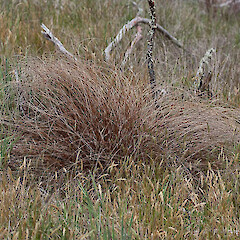Carex punicea
Common name
red bastard grass, frost flat hook grass
Synonyms
Uncinia rubra Boott var. fallax Kük.; Uncinia rubra Boott
Family
Cyperaceae
Flora category
Vascular – Native
Endemic taxon
Yes
Endemic genus
No
Endemic family
No
Structural class
Sedges
NVS code
The National Vegetation Survey (NVS) Databank is a physical archive and electronic databank containing records of over 94,000 vegetation survey plots - including data from over 19,000 permanent plots. NVS maintains a standard set of species code abbreviations that correspond to standard scientific plant names from the Ngä Tipu o Aotearoa - New Zealand Plants database.
UNCRUB
Chromosome number
2n = 88
Current conservation status
The conservation status of all known New Zealand vascular plant taxa at the rank of species and below were reassessed in 2017 using the New Zealand Threat Classification System (NZTCS) – more information about this can be found on the NZTCS website. This report includes a statistical summary and brief notes on changes since 2012 and replaces all previous NZTCS lists for vascular plants.
Please note, threat classifications are often suggested by authors when publications fall between NZTCS assessment periods – an interim threat classification status has not been assessed by the NZTCS panel.
- Conservation status of New Zealand indigenous vascular plants, 2017 . 2018. Peter J. de Lange, Jeremy R. Rolfe, John W. Barkla, Shannel P. Courtney, Paul D. Champion, Leon R. Perrie, Sarah M. Beadel, Kerry A. Ford, Ilse Breitwieser, Ines Schönberger, Rowan Hindmarsh-Walls, Peter B. Heenan and Kate Ladley. Department of Conservation. Source: NZTCS and licensed by DOC for reuse under the Creative Commons Attribution 4.0 International licence.
2017 | Not Threatened
Previous conservation statuses
2012 | Not Threatened
2009 | Not Threatened
2004 | Not Threatened
Distribution
Endemic. New Zealand: North Island, South Island and Stewart Island/Rakiura. From about Mt Pirongia and Te Urewera (though mainly found within the Central Volcanic Plateau) south. In the South Island present in Nelson thence east of the main divide.
Habitat
Montane to alpine (coastal in southern part of range). In frost-flats, short and tall tussock grassland, grey and subalpine scrub, bogs and mires. In the North Island it has been very rarely collected from cloud forest (Mt Pirongia).
Wetland plant indicator status rating
Information derived from the revised national wetland plant list prepared to assist councils in delineating and monitoring wetlands (Clarkson et al., 2021 Manaaki Whenua – Landcare Research Contract Report LC3975 for Hawke’s Bay Regional Council). The national plant list categorises plants by the extent to which they are found in wetlands and not ‘drylands’. The indicator status ratings are OBL (obligate wetland), FACW (facultative wetland), FAC (facultative), FACU (facultative upland), and UPL (obligate upland). If you have suggestions for the Wetland Indicator Status Rating, please contact: [Enable JavaScript to view protected content]
FAC: Facultative
Commonly occurs as either a hydrophyte or non-hydrophyte (non-wetlands).
Detailed description
Dark red, wine-red or reddish green, weakly tufted or shortly rhizomatous plant. Culms 150–350 × < 1 mm, rigid, wiry, minutely scabrid on the angles under the inflorescences Leaves 2–5 per culm, much < to slightly > culm, 0.7–2.5 mm wide, rigidly flexuose to rigid, margins slightly scabrid, tapering rather abruptly towards the tip. Spikes 25–70 × 3–5 mm, usually ebracteate, female flowers 8–11, often aborted, internodes to 10 mm long at base of spike, 3–6 mm long above. Glumes = or < utricles, persistent, obtuse or lowermost subacute, coriaceous, red with a pale margin. Utricles 5.0–6.5 mm long, plano-convex, concavo-convex or subtrigonous, fusiform, striated, yellowish green, later yellow-brown, narrowed above to a beak 1.0–1.5 mm long, and scarcely narrowed below to a paler stipe 1.0–1.5 mm long.
Similar taxa
A very distinctive species, easily recognised by the normally dark red to wine-red, rigid, wiry, weakly tufted culms. The species appears to be uniform throughout the North Island (populations there have leaves ½ the length of the culms and 1.0–1.5 mm wide), while in the South Island the leaves and culms are often slightly wider, and plants may occasionally be reddish-green.
Flowering
October–November
Fruiting
November–June
Propagation technique
Easily grown from fresh seed and by division of established plants—though these may take a while to settle. Prefers moist soil in a a semi-shaded site. However, once established will tolerate a wide range of conditions A very attractive species well worth cultivating. A red form of Carex uncinata L.f. is often sold erroneously labelled as this species.
Etymology
carex: Latin name for a species of sedge, now applied to the whole group.
Attribution
Fact sheet prepared for NZPCN by Peter J. de Lange 17 August 2006. Description adapted from Moore and Edgar (1970).
References and further reading
Moore LB, Edgar E. 1970. Flora of New Zealand, Volume II. Indigenous Tracheophyta: Monocotyledones except Gramineae. Government Printer, Wellington, NZ. 354 p.
NZPCN Fact Sheet citation
Please cite as: de Lange, P.J. (Year at time of access): Carex punicea Fact Sheet (content continuously updated). New Zealand Plant Conservation Network. https://www.nzpcn.org.nz/flora/species/carex-punicea/ (Date website was queried)



